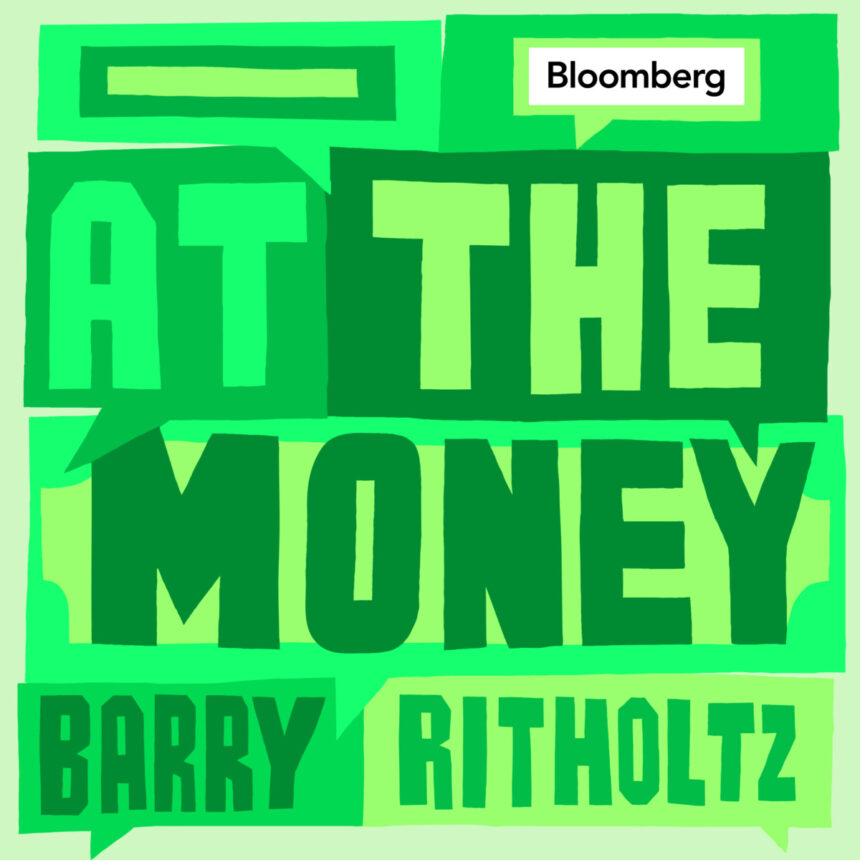At The Money: Underperforming Your Own Investments with Jeffrey Ptak, Morningstar (October 15, 2025)
Are you underperforming our own investments? Did you know that many, maybe even most, investors do worse than the ETFs and Mutual Funds they hold do? The annual Morningstar study “Mind the Gap” has found a substantial difference between returns generated by investment funds and the actual returns investors experience.
Full transcript below.
~~~
About this week’s guest:
Jeffrey Patak is the managing director at Morningstar. Previously, he was the chief ratings officer. He oversees the firm’s “Mind The Gap” research.
For more info, see:
~~~
Find all of the previous At the Money episodes here, and in the MiB feed on Apple Podcasts, YouTube, Spotify, and Bloomberg. And find the entire musical playlist of all the songs I have used on At the Money on Spotify
APPLE EMBED
Transcript:
[Musical intro: Yearning For Your Love The Gap Band)
What would you say if I told you that most investors underperform not only the benchmarks but their own investments? That’s the conclusion of an annual study by Morningstar titled Mind the Gap. It examines the differences between returns generated by investment funds and the actual returns investors experience. The difference between the two. It’s a substantial performance gap driven in large part by investor behavior.
I have the perfect person to discuss this with. Jeffrey Patak is the managing director at Morningstar. Previously, he was the chief ratings officer there. He joined Morningstar in 2002.
Jeffrey, let, let’s start with the basics.: What is the investor return gap and how large is it?
Jeffrey Patak: So the investor return gap is the difference between our estimate of the average return of a funder or a group of funds, and that funds its total return, it’s stated return.
What’s the difference between the two of those things the former takes into account the timing and magnitude. Of cash flows that have come and gone to and from the fund over time, whereas a total return, which most of us are familiar with from popping onto bloomberg.com or morningstar.com, assumes an initial lump sum investment.
When you compare the two of them, you can derive a sense of the impact of the timing and magnitude of buys and sells over time. To cut to the chase, when we estimated that for the trailing 10 years ended December 31st, 2024, we found that there’s a 1.2 percentage point annual return gap compared to the fund’s aggregate total return.
What that meant is that. The timing and magnitude of cash flows, it basically cost investors around 15% of their aggregate total returns.
Barry Ritholtz: That, that’s unbelievable. That’s a giant, giant shortfall. H how do you calculate that gap? It’s easy to figure out what a fund, an ETF, A mutual fund is actually generating. How do you figure out the shortfall that individual investors are suffering?
Jeffrey Patak: It it’s akin to an internal rate of return estimate. So we pool all US open-end fund and ETF assets together. That’s their beginning net assets, their monthly net flows. So that’s 120 monthly net flows. We impound into the calculation as well as their ending net asset.
We dump all of that into a calculation that derives essentially the constant return that would reconcile the beginning assets to the ending assets after taking those cash flows into account. All the data we use is data that Morningstar collects. So funds report their assets as well as their flows, and so we scoop that up and, and we plug it in.
Barry Ritholtz: What sort of funds does this include? I assume this is mutual funds and ETFs. Anything else in the, in the package?
Jeffrey Patak: You got it. It encompasses us open-end mutual funds as well as ETFs. It wouldn’t include things like closed-end funds in, in all. There were around 26,000 individual funds and ETFs that together held around $25 trillion in assets.
By the end of our study period. So it’s, it’s quite a comprehensive study.
Barry Ritholtz: I’m fascinated by the difference between time-weighted rate of returns for funds and asset-weighted returns. Explain the two ’cause really, that makes a giant difference, doesn’t it?
Jeffrey Patak: It does indeed. Yes. Your, your listeners are probably familiar with time weighted returns because that’s what they’d encounter in their normal affairs.
So I mentioned earlier if they where to pop onto bloomberg.com or morningstar.com, pull up a fund’s performance. Those are time-weighted return figures. The more popular power lens is total returns and, and a time weighted return. It assumes an initial lump sum investments that’s left untouched. Until the end of the period.
It’s sort of your classic buy and hold, whereas a dollar weighted return that takes the timing and magnitude of investors purchases and sales into account. It doesn’t assume people invest in initial lump sum and hold it to the end like a total return does. And so that’s essentially the difference between the two measures.
Barry Ritholtz: I’ve seen some interesting studies on hedge funds and on some ETFs. Where the time weighted return makes it look like a manager has done really well. And then when you see the dollar weighted return, most of the assets tend to flow in after they’ve had a big run up after the media has focused on them.
Some hedge fund managers look like they have great track records in terms of how well they’ve done for their investors are actually net losers over time. Do you see things that extreme when you’re looking at this data?
Jeffrey Patak: We do indeed. Unfortunately, I will say, in aggregate on balance, investors have gotten better and we can talk about some of the reasons for that, about capturing more of their funds, total returns then was formerly the case.
But yes, we do see some of these vivid examples of investors; schematically, they’re buying high end selling low. Sometimes it’s chasing behavior where investors pile in, just as you described, after a fund goes on a strong run only for performance to roll over, at which point they bail out. You know, and that can work in reverse where they sell before performance improves. Both of those things would dent their dollar-weighted returns compared to the fund’s total return.
Barry Ritholtz: It sounds like behavioral factors are a cause for investors suffering actually lower returns than their funds total return.
What other behaviors do you see that are a net negative? I think that sometimes it can be quite mundane where you will see an investor or someone you know representing them decide that they want to change the asset mix, and so it might not be in response to a particular funds performance.
It could be that for whatever reason, they just decided they want to be positioned differently. And so maybe they put more exposure on in an area that’s outperformed and take some weight off in an area that’s underperformed, only to see that wrong foot them over subsequent periods. Those are the sorts of decisions, behaviors that can give rise to gaps.
Barry Ritholtz: Mean reversion is a cruel mistress.
What about different types of funds? When we look at. Um, market cap size or geography, US versus international, how, how does the gaps form in those types of things?
Jeffrey Patak: Those are some of the dimensions that we look at as part of the study.
Sector equity funds have chronically suffered the widest gaps in absolute terms. In our most recent study, the average dollar invested in sector equity funds lag the funds total returns by one and a half percentage points a year. Over the dec over the decade ended December 31st, 2020. Which meant that investors failed to capture around 20% of those funds aggregate returns.
By contrast, we’ve seen the narrowest gaps among allocation funds. The most popular example of which are target date strategies. Those funds barely had an investor return gap over those 10 years ended December 31st, 2024.
The other thing I would note that ETFs had wider gaps than traditional open-end funds. We include both in the study over the 10 years ended December 24. If the average seller invested in ETFs lag, the ETFs aggregate total return by around 1.7 percentage points annually. Which is equivalent to around 18% of the ETFs total returns open-end funds. By contrast data, a narrower 1.2 percentage point per year gap over that timeframe.
ETFs are great in a lot of different ways. We just wanna make sure that we use them in the most prudent fashion
Barry Ritholtz: That, that makes sense. ETFs are a trading vehicle for some people, and we know what the long-term results of most people’s active trading is like.
I’m curious, how do the international funds stack up against domestic funds in terms of the gap?
Jeffrey Patak: The gap was slightly wider for international funds than it was for domestic equity funds. We found that there was a 1.1 percentage point annual gap. Whereas for US equity, it was about half that, it was about half a percentage point, 0.6 percentage points to be precise.
Barry Ritholtz: What role does market volatility play in this gap widening? I recall earlier this year when the tasks were rolled out in April, we saw a lot of frenetic activity. You can’t help but look at that and imagine very few people got that right.
Jeffrey Patak: Right you are our research has found a correlation at a couple levels. At an overall market macro level, as you allude to market fluctuations do tend to push investors buttons.
They’re much likely to make changes to their holdings, and this can work to their detriment and dollar weighted terms. We also look at this at an asset class level, you know, so US equity, international equity, taxable bonds, and on and on.
We also find there that the more volatile funds of a particular type have been harder for investors to successfully use than less volatile funds. So there are wider gaps with those too hard to handle funds that you would find in say, US equity or taxable bond as compared to their more sedate counterparts within those asset classes.
That’s been another sort of perennial finding from the study is that volatility pushes investors buttons, and when it does so they tend to capture less of their fund’s total returns.
Barry Ritholtz: You mentioned target date funds. I tend to think of target date funds or balanced funds, typically in 401k or retirement plans, where most people have a tendency to set and forget and just dollar cost average on a regular basis with each paycheck. Generally speaking, do we see less of a gap in retirement funds? Is it because of the specific long-term nature of target date funds? Or the fact that it’s in a 401k or 403B, what? What’s the advantage balanced funds, target date funds have.
Jeffrey Patak: I would say there’s two principle advantages. One is contextual. The other is related to the attributes, the characteristics of those strategies.
Let’s talk context first. They’re most often used in the context of a retirement plan. It’s a gilded cage of sorts. It’s really meant for investors to go in and save and compound over time; not for them to wheel around as they might in a brokerage account.
Then let’s talk about the characteristics of those vehicles as you reference. They’re highly automated. They take care of rebalancing. They adjust the asset mix as time goes on, they are, as you put it, set it and forget it, and that has worked to investors benefit.
We found that investors and allocation funds, they captured essentially all of their funds, total returns. That is, there was almost no gap among allocation funds over the 10-year study period that we were focused on.
I think that’s one of the most heartening stories to come out of our research is the fact that it seems that investors in retirement plans, or specifically those who invest in allocation funds have enjoyed some of the greatest success and that’s crucial to their retirement security.
Barry Ritholtz: So give investors some practical advice: What sort of steps can they take to minimize the gap; capture more of their investing funds, long-term returns?
Jeffrey Patak: So it might sound a bit trite, but I would say have a plan and automate as much of it as you can. Investors, they tend to get themselves in trouble when they engage in, you know, off cycle discretionary, ad hoc type of trading.
One can surmise that might be more likely to occur when there’s some sort of market disruption or tumult or a meta mania.
But if you have a plan and, and you’ve appropriately allocated your assets based on that plan, you know, widely diversifying across asset, then you have an anchor or a point of orientation, whereas without it, you might feel like you’re at sea. You know, also because you’ve spread out per the plan, diversifying widely, you’re less likely to experience the full brunt of a selloff and experience the kind of ruinous outcome that might induce panic.
Automating is the other key. Uh, I would say, you know, what we know about target date funds is they’re held in retirement plans.
But also they obviate the need for investors to take action to rebalance or to adjust the asset mix as they were near the retirement date. And that’s because those features are built in. I think one of the other clear takeaways from the research is that automation narrows gaps.
Barry Ritholtz: Investors can avoid the investor gap. They can avoid underperforming their own mutual funds and ETFs by simply having a couple of common-sense steps put into place: Don’t let volatility distract you. Don’t try and buy or sell when markets get frothy. Don’t think you’re gonna be able to time the market. And perhaps most important of all, you have to have a plan, and you have to be able to keep your emotions at bay. Otherwise, you’re gonna fall into the unfortunate fate of underperforming your own investments.
I’m Barry Ritholtz. You are listening to Bloomberg’s At the Money.











